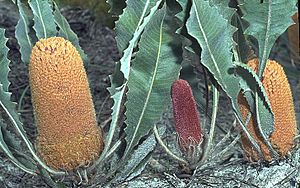Good's banksia facts for kids
Quick facts for kids Good's banksia |
|
|---|---|
 |
|
| Banksia goodii in Albany | |
| Conservation status | |
| Scientific classification | |
| Genus: |
Banksia
|
| Species: |
goodii
|
| Synonyms | |
|
|
Banksia goodii, commonly known as Good's banksia, is a special type of low-growing shrub. It's found only in a small part of Western Australia, near Albany. This plant has fuzzy stems, wavy leaves with jagged edges, and flowers that are a rusty-brown color. It's currently listed as "endangered," which means it's at risk of disappearing.
Contents
What Good's Banksia Looks Like
Good's banksia usually grows as a low bush, sometimes lying flat on the ground or with stems reaching up to 20 centimeters (about 8 inches) tall. It has a special underground woody base called a lignotuber, which helps it regrow after fires.
- Stems and Leaves: Both the stems and leaves are very hairy. When new leaves grow, they are a striking purple color. The older leaves are dark green with a bright yellow line down the middle. They stand upright and have a wavy shape, like an egg or oblong, with jagged edges.
- Flowers: The flowers grow in spikes that are 8 to 15 centimeters (about 3 to 6 inches) long. They are rusty brown with creamy-white parts called styles. Each flower is about 2.4 to 2.6 centimeters long, and the curved style is about 2.9 to 3.1 centimeters long.
- Flowering Time: Good's banksia flowers in May and November.
- Fruit: After flowering, it produces hairy, oval-shaped fruits called follicles. These are about 2.5 to 3.2 centimeters long. Sometimes, a flower spike won't produce any fruit, but other times it can have up to fifteen. The old flower spikes look hairy because the withered flower parts stay on them.
How Good's Banksia Got Its Name
Banksia goodii was first officially described in 1830 by a botanist named Robert Brown. He wrote about it in his book, Supplementum primum Prodromi florae Novae Hollandiae. The plants he studied were collected by William Baxter near King George's Sound in 1829.
- Meaning of the Name: The second part of the name, goodii, was chosen to honor Peter Good. He was a gardener who helped Robert Brown with his plant studies.
Where Good's Banksia Lives
Good's banksia grows in southwest Western Australia, between Albany and the Porongorup Range. It prefers shallow white or grey sand that sits on top of a hard, reddish rock layer called laterite.
- Habitat: You can find it in low forests and woodlands.
- Past Distribution: Scientists believe that Good's banksia used to grow in a much larger area. However, a lot of its original land was cleared for farming, which reduced where it can now be found.
Why Good's Banksia Needs Protection
Good's banksia is considered an "endangered" species. This means it's at high risk of disappearing from the wild.
- Current Numbers: There are only about 17 known groups of this banksia left. Each group has between 10 and 300 plants, adding up to roughly 1,000 plants in total.
- Official Status: It is listed as "vulnerable" under a special law called the Environment Protection and Biodiversity Conservation Act 1999. It's also listed as "Threatened Flora" by the Department of Environment and Conservation (Western Australia).
- Main Dangers: The biggest threats to Good's banksia include:
- Fire: Fires that happen too often or at the wrong time can harm the plants.
- Road Maintenance: Work done on roads can destroy their habitat.
- Land Clearing: Removing land for other uses, like farming, is a major problem.
The IUCN (International Union for Conservation of Nature) also lists this species as "Endangered." They believe that more than half of the Good's banksia population has been lost over the last 300 years, mainly because land was converted for other uses. They estimate there might be as few as 1,500 individual plants left.
Growing Good's Banksia
If you want to grow Good's banksia from seeds, you don't need to do anything special to the seeds first. They usually sprout within 19 to 56 days.
Taylor, Anne; Hopper, Stephen (1988). The Banksia Atlas (Australian Flora and Fauna Series Number 8). Canberra: Australian Government Publishing Service. ISBN 0-644-07124-9.


